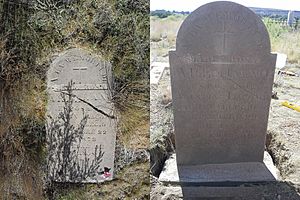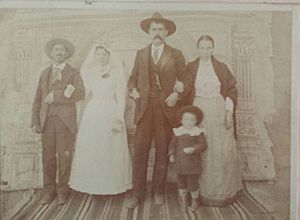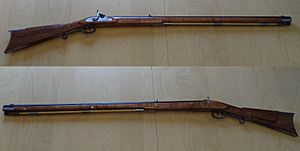Auguste Lacome facts for kids
Quick facts for kids
Auguste Sylvestre LaCome
|
|
|---|---|
| Born | October 25, 1821 Ordizan, France
|
| Died | November 11, 1888 |
| Occupation | Trader/merchant |
| Spouse(s) | Maria Rosa Arellano |
| Children | José Eulogia, Gabriel Augustin, Silvestre Augustin, Juan Bautista, Juana Josefa (adopted), Pedro Antonio (adopted), Juan Maria |
| Parent(s) | Jean Paul LaCome and Jeanette Doleac |
Auguste Sylvestre LaCome (born October 25, 1821 – died November 11, 1888) was a French explorer and trader. He settled in the New Mexico Territory, which is now part of the United States. Auguste was also the brother of Jean Baptiste (Juan Bautista) LaCome. He played a role in investigating the White massacre, a historical event.
Contents
Auguste LaCome's Life Story
His Early Years
Auguste LaCome was born in a town called Ordizan, close to the border between France and Spain. His family had an interesting background. His grandfather, Alexis Doleac, left his religious role to join the French Revolution. This was a big event in France about freedom and equality. Auguste's father worked as a medical officer, helping doctors.
Auguste had three other brothers besides Jean Baptiste. One brother, Joseph, also left France to travel to South America. Sadly, their three sisters did not live to be adults. Records sometimes say Auguste was born in France and sometimes in Spain. But people at the time called him a "Frenchman." He got a passport in 1842 and sailed from France to New Orleans. From there, he moved to the New Mexico Territory. Auguste was described as being about 5 feet 10 inches tall. He had chestnut hair and eyebrows, an oval face, and a pointed chin.
His Family Life
Auguste LaCome married Maria Rosa Arellano on April 26, 1855. Their wedding was in Arroyo Hondo. Maria Rosa was born in 1833 in what was then Mexican territory. This area later became part of the United States after the Mexican–American War. Her grandmother was known as "Josefa la Apache." Maria Rosa passed away when the LaCome family lived in San Luis, Colorado.
Auguste and Maria Rosa's Children
Auguste and Maria Rosa had several children:
- José Eulogia (born March 16, 1856 – died May 23, 1918)
- Gabriel Augustin (born February 2, 1858)
- Silvestre Augustin (born August 22, 1859 – died March 3, 1929)
- Juan Bautista (born April 6, 1862)
- Juana Josefa (an adopted Navajo girl, baptized at age 6 in 1862)
- Pedro Antonio (an adopted Navajo boy, baptized at age 12 in 1863)
- Juan Maria (born November 4, 1866 – died September 28, 1898)
About Juan Bautista, Auguste's Brother
Auguste and his brother, Juan Bautista, adopted a 3-year-old boy named José Pedro. He was a Southern Paiute boy. José Pedro was baptized on May 10, 1852. Juan Bautista and his wife, Maria Dolores Alire, were his godparents. This boy had been bought as a captive by a priest named Cura José Thomas de Jesus Abeita.
Sadly, Juan Bautista was killed later that same month, on May 28, 1852. After his death, Juan Bautista's wife and children lived with Auguste and Maria Rosa.
Juan Bautista and Maria Dolores's Children
Juan Bautista and Maria Dolores had two children:
- Francisco Agustin
- Juan Bautista
Auguste's Trading Adventures
Missions with the Ute People
Auguste LaCome was a licensed trader. In 1850, he got permission to trade with the Ute people. He was not allowed to trade weapons or war items. He was also asked to search for survivors of the White massacre and see if they could be rescued.
Auguste met with peaceful Ute leaders. They confirmed that a child from the massacre had been taken by another group, the Jicarilla Apache. The child was killed soon after an attack on their camp. Auguste reported this information a few weeks later.
Later that year, Auguste went on another mission. He traveled with an interpreter and two helpers called peons. He met a Ute group who took his rifle and divided his trade goods. These goods were worth about $690. This group of Utes said they did not want peace with the United States. They even shot an arrow at Auguste, but his interpreter moved the Ute holding the bow, and it missed. After a lot of talking, the Utes decided to only whip the interpreter and one peon. Auguste got his rifle back because it was too heavy for them. He also got back some of his old mules, oxen, and cows.
Because of these events, Auguste and other citizens asked for a military campaign against the Apache. Kit Carson, a famous frontiersman, also signed this request. These growing conflicts eventually led to the Jicarilla War.
Other Trading Journeys
In 1852, Auguste LaCome took items like knives, tobacco, coffee, and sugar to trade with the Navajo people at Cañon de Chelly. He returned a month later.
His trading licenses show that he traded with the Navajo and other Pueblo people. They also show he lived in San Luis, Colorado, and Rio Colorado, New Mexico. He even traded as far away as Wyoming and Nebraska.
Important business people like the Spiegelberg Brothers and Abraham Staab helped Auguste get the special permits needed to trade with Native American groups. Auguste was also friends with Manuel Álvarez, who was a fellow trader and lieutenant-governor of New Mexico. They often did business together.
In 1860, records showed Auguste was a merchant. He owned property worth about $2,000 and other goods worth $8,000. This would be like owning about $55,500 in property and $225,000 in goods today. In 1872, a newspaper article listed Auguste's store as one of three in San Luis, Colorado.
His Hawken Rifle
Auguste LaCome's special rifle is on display at the Palace of the Governors museum in Santa Fe. It's a .58 caliber rifle, which means the bullet is about half an inch wide. It's a Hawken rifle style, known for being strong and reliable. The rifle is about 53 inches long.
This rifle was originally a "fullstock," meaning the wood part went all the way to the end of the barrel. But it was either damaged and fixed, or changed on purpose to a "halfstock." This means the wood part was shortened. New parts were added to the rifle during this change.
Running for Senate
In 1876, Colorado held its first state elections. Auguste LaCome, at age 55, decided to run for State Senate in Costilla County, Colorado. He ran against William H. Meyer. Meyer later became the lieutenant governor of Colorado. Auguste lost the election, with Meyer getting 349 votes and Auguste getting 204 votes.
Death and What He Left Behind
Auguste LaCome passed away on November 11, 1888. He was buried under the floor of the Nuestra Señora de los Dolores church in Arroyo Hondo.
Auguste's son, José Eulogio, took over his trading business. José Eulogio became a sheriff and a state lawmaker in New Mexico. He also owned a saloon, a hotel, and even silver and gold mines. Another son, Sylvestre Augustin, built a house in Arroyo Hondo that is still standing today on LaCome Road.
Images for kids
See also





